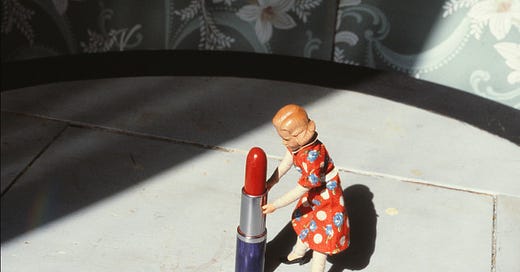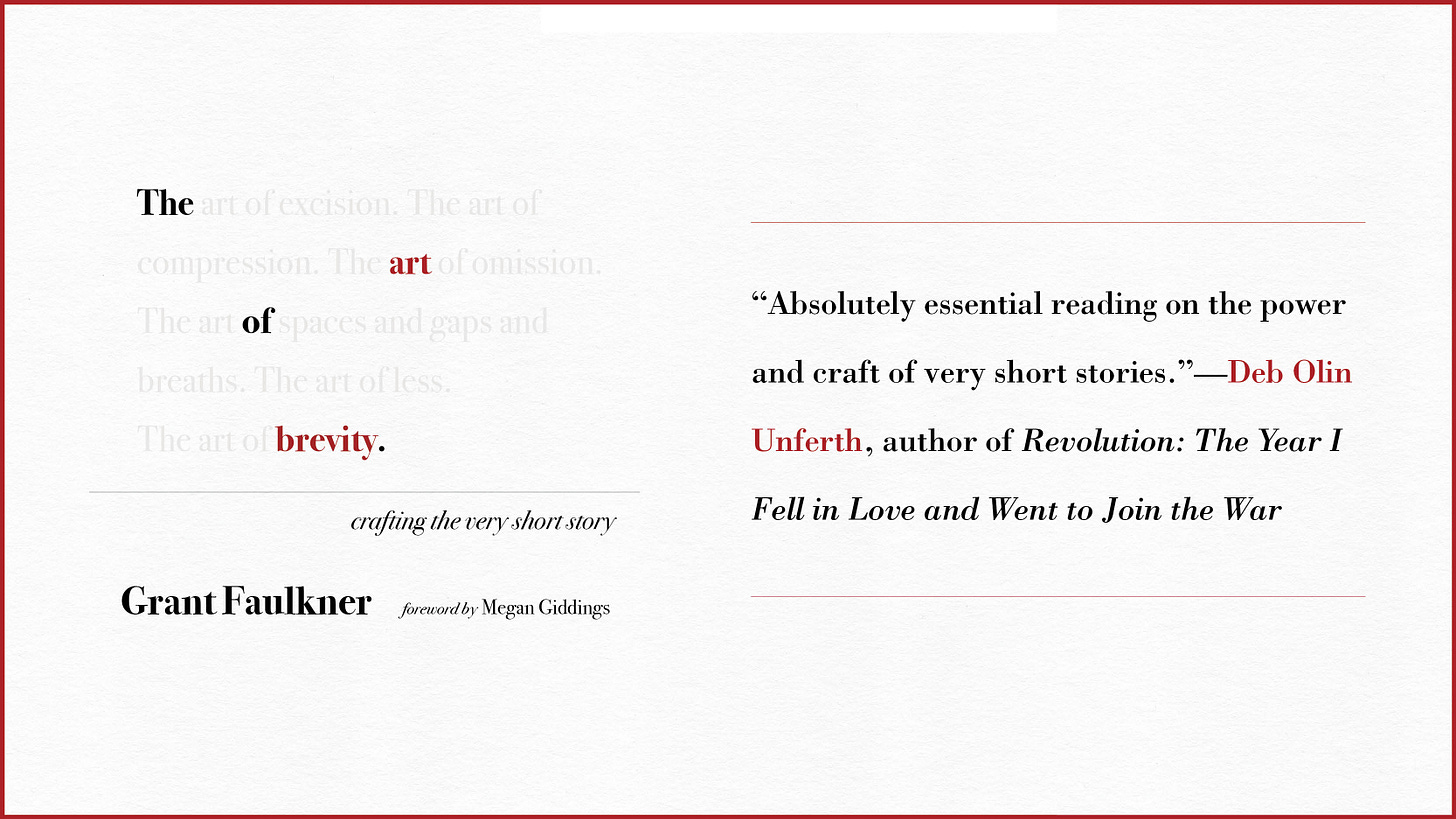Small Things that Illuminate Big Spaces
A grab bag of snippets from "The Art of Brevity" to celebrate its birthday
I’m a bad parent. I’ve been so busy this year that I forgot to mark the third birthday of The Art of Brevity, which is actually my favorite book that I’ve written on writing.
It’s the book I most often speak about and teach—so reach out to me if you’d like to book me! I’ve spoken with a lot of writing/reading groups as well.
I’m a committed birthday person for myself (see my Oldster interview), so I want to celebrate all this book has given to me by sharing some of my favorite snippets from it—call it a grab bag of brevity.
A grab bag of snippets is the perfect metaphor for flash fiction.
Let’s start with a metaphor
“A flash story is like a firefly, Molly Giles once said. The beauty of a firefly’s light is not how it illuminates the world, as the sun does, but in how it illuminates the darkness. Sometimes it takes the smallest of things to open up the biggest of spaces.”
Flash has an … erotic aesthetic
“Dorothy Parker said, ‘Brevity is the soul of lingerie.’ A flash story is the lingerie itself: an invitation to come hither, a promise, a hint.”
“Is not the most erotic portion of the body where the garment gapes?”
—ROLAND BARTHES
On constraints
“I guess the challenge has always been for me, the most interesting challenge is how do you take a constraint and turn it into an opportunity to make something really unique in the world?”
—MEEJIN YOON
“Barriers can lead to breakthroughs. The magic emerges because of the limitations of the form. Without constraints, we might not feel the piquant pressure that pushes us to find exactly the right word.”
Making stories with fragments
“Life isn’t a round, complete circle—it’s shaped by fragments, shards, and pinpricks. It’s a collage of snapshots, a collection of the unspoken, an attic full of situations you can’t quite get rid of.”
“I like to deal with fragments. Because no matter what the thought would be if it were fully worked out, it wouldn’t be as good as the suggestion of a thought that the space gives you. Nothing fully worked out could be so arresting, spooky.”
—ANNE CARSON
“Think of it like a planarian, a flat worm that, if you cut it into pieces, will grow back into a worm. The fragment is both unto itself and connected to something larger. It’s always growing.”
Please become a paid subscriber to this newsletter …
White space
“Imagine the moment a bell is rung, how its sound dissipates into the air, how it’s defined by silence as it becomes silence. The white space in a story functions like that air surrounding a sound. It allows a piece of art to breathe.”
“Super-short paragraphs and line breaks can aerate prose, throwing light into density, giving the reader space to think. They also create dynamism, letting the eye swing to the left more often, each swing shifting the thought.”
—JANE ALISON
“The thresholds of white spaces in a work build emotion, ask questions, and speak their own sort of dialogue.”
Plotting—and not plotting
“Instead of concerning itself only with what happens next, flash fiction is capable of pushing outwards in every direction. It poses questions and feels free of the burden to provide answers for everything. As in real life, not all things can be easily solved, not everything is a happy ending.”1
—JOYCE CHONG
“One might say that these short-shorts constitute epiphanies (climactic moments of high grace or realization) that have been torn out of their contexts.”
—IRVING HOWE
“The shorter the piece of fiction, the less need for a plot. You can write a fine story in which little happens: A man curses his neighbor, a widow quits her mahjongg group, or an unhappy family goes on a picnic. Simple shapes work better than something fussy and complicated.”
—JEROME STERN
“A short story, in its brevity, may not have a fully developed plot, but it must have the essence of a plot, yearning.”2
—ROBERT OLEN BUTLER
“A plot-driven narrative seeks resolution and conclusion whereas works of brevity often seek irresolution. These are stories that hang in the air, unfinished.”
The art of omission
The gaps within and around the story speak as largely as the text itself.
“Brevity allows us to get close to the unsayable, to know something that is beyond words or the wordless moments words bring us to.”
“Flash communicates via caesuras and crevices. There is no asking more, no premise of comprehensiveness, because flash fiction is a form that privileges excision over agglomeration.”
Ambiguity as craft tool
The oblique is one purpose of flash. Flash is the art of the sidelong glance.
“There is a question every writer must ask: When does minimalism become too minimal to provide a readable map? When does understatement edge past clarity toward confusion? ‘Incoherence is preferable to a distorting order,’ Barthes wrote. But what is the right level of ‘incoherence’ in a story?”
“To read such pieces, especially miniatures, you have to adjust your gaze, put on a different mental lens. You have to allow for incoherence and distortions and disconnections. You have to give up your expectations of what a story is supposed to be.”
Creating context
“Bonsai art is the display of a landscape—without the landscape,” said the bonsai artist Nobu Kajiwara. As is flash fiction.
Writing flash is mainly about editing
“In looking for what to prune, you become more attuned to a story’s contours. You feel the story in ways you didn’t before.”
“Whereas a novelist is a spinner of tales, a miniaturist prefers to whittle things down in search of the perfect contour.”
Every word is part of an orchestra
“Each word is a single note, gaining meaning from the concerto it finds itself in, its resonance never static, never inert.”
“The music of language is a concentrating force as well. It creates intimacy with the rhythms of a writer’s imagination, its cadences communicating hints of irony or sincerity, humor, or distress.”
“A good writer listens for the peal of the vowels and the sibilance of consonants, identifying the acoustical zones of a sentence and tuning or mistuning the sounds as needed.”
A different type of storytelling
“Brevity allows the rags and detritus of the everyday to become gems and jewels. Precious because they might go unnoticed otherwise.”
“The small has its own language, its own special timbre.”
“Flash allows stories to capture the running water of the everyday. Suddenly, the strain of music heard faintly from the next apartment becomes the reason for a story itself.”
Characters in fleeting profile
“Instead of going for the surface description of telling what the character looks like or how the character walks, find that piercing, revealing detail that tells the essence of their character.”
“A writer of brevity has to paint characters in deft brushstrokes, with the keenest of images in such limited space, in order to capture their essence.”
The title
“Because a flash story is so short, the title has to do more work. Or, another way to put that is there’s the opportunity for it to do more work.”
Endings
“The realized one-page fiction must move palpably beyond the page, like a ghost self … The one-page fiction should hang in the air of the mind like an image made of smoke.”
—JAYNE ANNE PHILIPS
Please buy The Art of Brevity!
I’m available for book coaching and editing!
Contact me to find out more about my one-on-one work with writers.
Because a photo
A little house in a tree. No big people allowed.
One thing I love about flash: it’s an opportunity to redefine the shape of plot.
This is perhaps my favorite definition of plot.









Love your advocacy for brevity, Grant.
I'm not so sure flash is different. Resolution is pleasing, regardless of length.